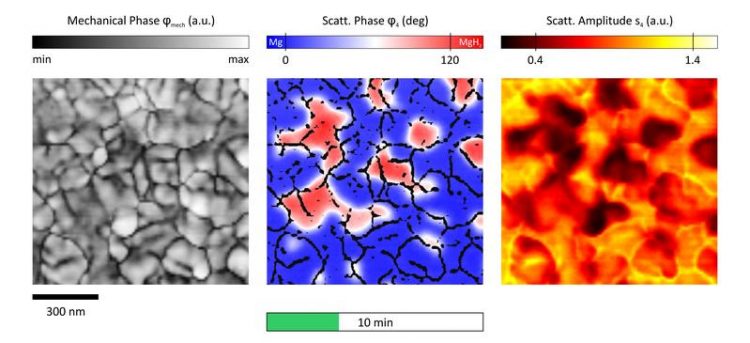Scientist from the University of Stuttgart reveal switching mechanism of plasmonic pixels based on magnesium

In-situ Dynamik der Magnesiumhydrid-Bildung in Magnesium mit Nanometer-Auflösung, gemessen mit streuungssensitiver optischer Raster-Nahfeld Mikroskopie. Photo: Universität Stuttgart / PI 4
The size of pixels in state-of-the-art switchable optical devices is intrinsically limited by the fabrication of micrometer-sized transistors and spatial light modulators. To further decrease their size, several approaches are currently under debate and investigated in research labs all over the world.
One promising route can be found in the field of nanoplasmonics. A plasmonic nanoparticle typically has sizes of only several tens of nanometers and can focus light into sub-wavelength dimensions with an extreme localization of electro-magnetic fields.
By adjusting the size of such particles, their color appearance can be shifted through the entire visible spectral range. In combination with phase-transition materials their optical properties and their appearance can be tuned, colors can be turned on and off, and one can realize switchable colored plasmonic pixels with nanometers size.
One promising material for this purpose is magnesium. The well-known metal can, under external stimulus, hydrogenate to a dielectric insulator with an extreme optical material contrast. This makes it an ideal candidate for optically active and switchable systems such as dynamic holography, plasmonic color displays, or switchable metamaterials.
So far, the optical switching from metallic magnesium to dielectric magnesium hydride with hydrogen is strongly limited by intrinsic material factors and obstacles such as the volume expansion of the material, poor cyclability, and limited diffusion coefficients.
Switching processes at previously unattained nanometer Resolution
Researchers from the 4th Physics Institute at the University of Stuttgart have succeeded for the first time to image and watch the switching process of this smart material with the required nanometer resolution to understand and analyze the influence of nanoscale morphology on the hydrogenation.
In his experiment, Julian Karst from the group of Harald Giessen uses free-standing magnesium to image in-situ its nanoscale optical and morphological properties. The measurements reveal an extreme influence of morphology on the nanoscale optical switching mechanism and highlight the possibility for significant future improvements of the optical switching performance.
Towards 3D holographic Virtual Reality
Harald Giessen believes that their published work will help in the future to develop, design, and analyze high-performance pixelated smart material optical devices with nanometer-sized pixels.
Furthermore, as magnesium is also a very promising candidate for hydrogen storage, he believes that the results on the diffusion processes on the nanometer scale will aid the improvement of the hydrogen storage efficiency. It might pave the way to realize 3D holographic virtual reality glasses in a few years.
Prof. Harald Giessen, Julian Karst, University of Stuttgart, 4th Physics Institute, Phone +49 711 685-65111, E-Mail giessen@pi4.uni-stuttgart.de
J. Karst, F. Sterl, H. Linnenbank, T. Weiss, M. Hentschel, H. Giessen: Watching in situ the hydrogen diffusion dynamics in magnesium on the nanoscale, Sci. Adv. 6, eaaz0566 (2020). DOI: 10.1126/sciadv.aaz0566, https://advances.sciencemag.org/content/6/19/eaaz0566
https://www.pi4.uni-stuttgart.de/img/news/news_2020/2020-05-08_High_Resolution_D… (Movie)
Media Contact
All latest news from the category: Physics and Astronomy
This area deals with the fundamental laws and building blocks of nature and how they interact, the properties and the behavior of matter, and research into space and time and their structures.
innovations-report provides in-depth reports and articles on subjects such as astrophysics, laser technologies, nuclear, quantum, particle and solid-state physics, nanotechnologies, planetary research and findings (Mars, Venus) and developments related to the Hubble Telescope.
Newest articles

First-of-its-kind study uses remote sensing to monitor plastic debris in rivers and lakes
Remote sensing creates a cost-effective solution to monitoring plastic pollution. A first-of-its-kind study from researchers at the University of Minnesota Twin Cities shows how remote sensing can help monitor and…

Laser-based artificial neuron mimics nerve cell functions at lightning speed
With a processing speed a billion times faster than nature, chip-based laser neuron could help advance AI tasks such as pattern recognition and sequence prediction. Researchers have developed a laser-based…

Optimising the processing of plastic waste
Just one look in the yellow bin reveals a colourful jumble of different types of plastic. However, the purer and more uniform plastic waste is, the easier it is to…


